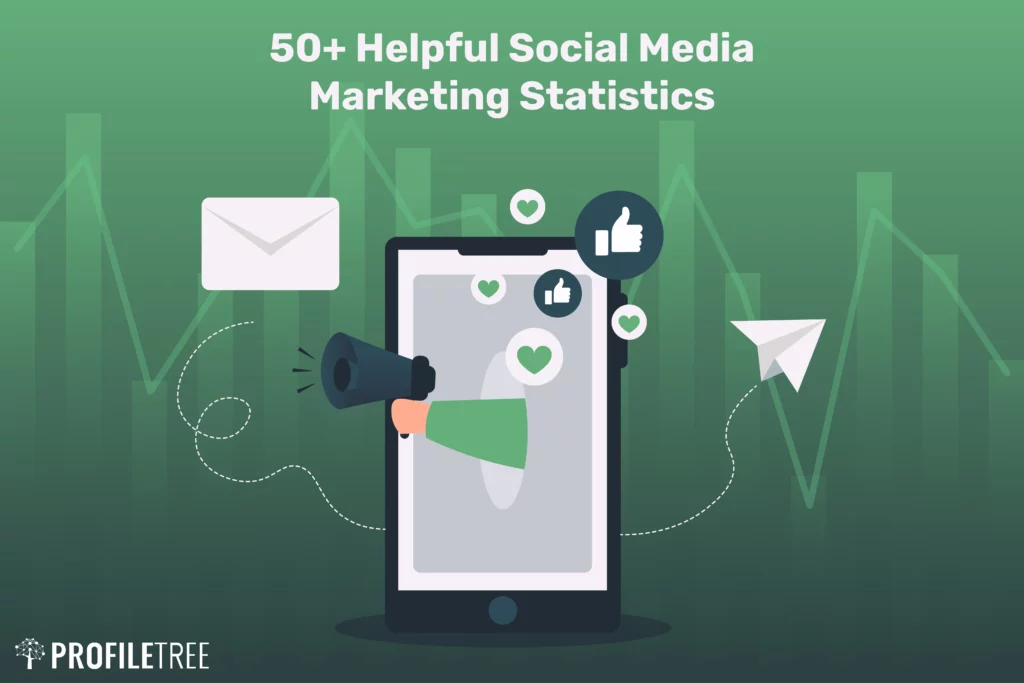Statista showed that social media users would exceed 4.9 billion in 2023. This is about half of the entire human population on Earth. It’s expected to reach 5.85 billion social media users globally by 2027.
Social media audits have become crucial for businesses in 2023. With over 4.55 billion global social media users, platforms like Facebook, Instagram and TikTok continue to evolve rapidly. Conducting regular social media audits allows companies to keep up with changes and maintain a competitive edge.
Recent industry reports show that 43% of consumers expect brands to provide customer service through social media. Meanwhile, 66% of social media users say companies should interact with followers and respond to comments and messages. Failing to engage audiences and monitor social presence can harm the brand’s reputation and cause a loss of customers.
This is why performing comprehensive social media audits is key. Audits evaluate all aspects of a company’s social media strategy and uncover areas for improvement. Following a step-by-step audit process ensures you gather useful insights that inform impactful changes.
In 2023, social media users are as follows:

- Facebook Active Users – 2.91 billion
- Twitter Active Users – 436 million
- YouTube Active Users – 2.56 billion
- Whatsapp Active Users – 2 billion
- Instagram Active Users – 1.47 billion
On average, the typical social media user uses 6.6 social media platforms. Eastern Asian users are the most people consuming social media, representing 26% of the global population. That said, social media is used by more than 85% of the world’s 5.72 billion smartphone users.
SEE ALSO: Benefits of Social Media Marketing
Table of Contents
What is a Social Media Audit?
A social media audit is a comprehensive assessment of your social media presence. It involves reviewing your profiles, content, engagement, and overall strategy. The goal of a social media audit is to identify areas for improvement and develop a plan for optimizing your social media performance.
The percentage breakdown of social media usage when comparing engagement is as follows:
- Despite gloom and doom, Facebook is still the most-used platform by marketers – Instagram comes in second place.
- Instagram dominates social streaming services when it comes to engagement (81%)
- LinkedIn ad revenue reached $1 billion in 2021, growing by 37%, while organic session engagement exceeded 22%.
- Twitter’s revenue amounted to $1.284 billion as of Q3 2021.
- Pinterest boasts over 400 million monthly active users ,and over 240 billion pins have been saved.
Social media has a powerful influence on Internet users who increasingly use mobile devices. 99% or over 4 billion social media users access their accounts using a mobile device.
For organizations to understand how effective their presence is on social media, they need to conduct a social media audit regularly.
Conducting a Complete Social Media Audit:
- Set goals. Clarify what you aim to learn from the audit to guide the process. Common goals include benchmarking engagement rates, identifying brand mentions and influencer opportunities, evaluating performance by platform and more.
- Gather data. Use social media management tools like Hootsuite, Sprout Social and Rival IQ to pull key metrics across platforms—track followers, interactions, engagement, clicks, mentions, sentiment, and follower demographics.
- Analyze competitors. See how competitor social media accounts compare to yours. Examine their content strategy, aesthetics, messaging and engagement levels. This reveals their tactics and where you can improve.
- Evaluate posting strategy. Audit the frequency, timing, variety and quality of your social content across platforms. Identify what types of posts, formats and topics resonate best with your audience.
- Assess engagement. Look at follower interactions with your content and brand. Check response rates, click-throughs, likes, shares, comments, etc. This shows what content and tactics encourage engagement.
- Check branding consistency. Review profile info, imagery, messaging and tone of voice across platforms. Ensure your branding is cohesive.
- Monitor mentions and sentiment. Use social listening tools to find brand mentions and see how users perceive your brand online. This reveals pain points to address and outreach opportunities.
- Create an improvement plan. Based on audit findings, set SMART goals and assign tasks across your team to update strategies and tactics.
Analyzing Audit Findings and Creating an Action Plan:
The key to making your social media audit effective is properly analyzing the data and turning insights into strategic next steps.
Start by identifying major takeaways, strengths and weaknesses across platforms. Look for patterns and themes. Compare metrics to industry benchmarks.
For example, your Facebook engagement rate may be 2% lower than your competitors. Twitter follower growth might have stagnated versus rapid Instagram growth. TikTok videos outperform static image posts across the board.
Pinpoint areas needing improvement, such as inconsistent branding, low organic reach, poor click-through rates, etc. Find gaps where competitors are outperforming you.
Determine why these issues exist. Is poor click-through rate due to ineffective calls to action? Are followers disengaged because content lacks relevance? Does inconsistent branding cause brand confusion?
Next, turn-key findings into S.M.A.R.T. social media goals and tactical plans:
- Specific – Target fixing identified weaknesses.
- Measurable – Metrics to benchmark progress
- Achievable – With proper tools and resources
- Relevant – Align goals to business objectives
- Time-bound – Set deadlines for implementation
Prioritize goals based on potential business impact. Assign tasks and resources to execute. Set follow-up audit dates to track progress. Frequent audits ensure your strategy evolves along with social platforms.
Benefits of Conducting Social Media Audits:
- Optimize engagement levels and reach wider audiences.
- Uncover new marketing opportunities and partnerships.
- Adapt branding, content and activities to current trends.
- Identify influencers and evangelists to leverage.
- Resolve customer pain points and improve satisfaction.
- Keep up with competitors and industry benchmarks.
- Inform strategic decisions with data-based insights.
- Improve efficiency by reallocating resources properly.
Social Media Audits: Tracking Your Profile’s Performance

Conducting a social media audit monthly is best. The audit may be as simple as using a spreadsheet to gather and track historical information as it changes over time.
The basic information tracked includes:
- Profile information, which needs to be current
- Frequency of postings made to the social media account
- Number of followers
- Web traffic referred by others
- Any special metrics of a particular social media channel, such as “likes” on Facebook
It is important to track the changes from month to month and compare them with the same time last year.
Analytical Tools
Besides simply tracking the basic information, there are also analytical webmaster tools that are helpful when examining some of the metrics of the social media audit.
A typical analysis of social media activity includes information about:
- Engagement of users in each social media system
- Facebook activity shows friends, likes, links, page impressions, and the number of people talking about a subject related to an organization.
- Twitter activity, including demographics, retweets, link clicks and listening for certain keywords
- Instagram activity that captures related photo posts using hashtag analysis
- A Google Analytics report that summarizes search engine activity combined with tracking social media activity
- Messages sent and received
- Trends analysis, including group summaries of information from all social media sources
- Advanced analytics discovers important influencers for certain keywords and topics.

Goals of a Social Media Audit
A social media audit comes from understanding an organization’s goals for using social media. Performance benchmarks are set, and then the social media audit compares the actual results based on quantifiable parameters with the benchmarks of the goals.
Strategic Use of Social Media
Examples of performance benchmarks, derived from the objectives of the organization that are measurable, include such things as measuring awareness of a brand, determining customer loyalty by tracking repeat business, monitoring web traffic, sales comparisons from period to period, retention of customers and demand for customer support.
Return on Investment
A social media audit calculates the return on investment (ROI) compared to the benchmark performance results. For example, if the organization’s goal is to obtain new customers, the number of new customers and their long-term value to the company is compared with the cost of customer acquisition through social media channels.
It is easier to calculate the ROI for social media campaigns when the benchmarks are conversions or sales.
Sometimes the return on investment is hard to reduce to a dollar amount or a percentage. Instead, it may be a calculation of brand awareness achieved by counting social media interactions. This calculation compares the contribution that an organization makes to social media with the number of social contributions this contribution causes to occur from others.
Optimize Smart explains an example like this.
Here are some possible social contributions made by an organization:
- Facebook status update
- A “tweet” placed on Twitter
- A photo or reel posted to Instagram
- A post or an announcement to LinkedIn group members
Suppose a company shares a post using any of the above methods. In that case, the tracking of the replies shows whether the return of social contributions by others is greater or less than the organizational efforts. Ideally, the replies should be at least twice the organization’s social contributions. It is even better if the replies come from a treasured demographic or geographical location that is part of the organization’s target audience. A high amplification rate, where the social media responses vastly exceed the organization’s social media contributions, causes certain content to go “viral.”
Regardless of whether or not the social media audit results in an actual dollar cost versus dollar return comparison or a comparison of the ratio of social responses to social contributions, there should be a clear metric tracked by the social media audit to see if the social media efforts produce positive results.
Moreover, it is important to compare the effectiveness of different social media channels and focus social media efforts on the channels producing the best results.
A useful tool that offers a free 30-day trial is the True Social Metrics Tool. This tool helps to calculate the amplification rate of social media contributions.
Amplification increases when an organization becomes influential in a certain niche. It also increases by having a positive impact on others that have influence. One thing to track with the social media audit is the contributions that produce the greatest amplification. When an organization sees how a particular social media contribution creates amplification, it can create similar content in the future to increase positive results.
If an organization’s reach is global, it is important to release new content on social media at times of day when there is more activity. This is usually in the evenings and on weekends for the local time zone. For global participants, posting social contributions on local social media sites in the local language is a terrific idea.
Evaluation of the Social Media Strategy
As noted by Optimize Smart, the social media audit uncovers weaknesses in the overall social media strategy by analyzing the following factors:
- Clear identification of the target audience
- Achievement of quantifiable goals
- Preparation of unique, quality content used for social media campaigns
- Alignment of social media content with the organization’s overall marketing plans
- Frequency and consistency of publishing on social media channels
- The advertising budget for social media channels to support “organic” promotional efforts
Target Audience
One of the problems with the widespread use of social media is that exposure through social media channels does not target the most beneficial users for an organization’s promotional efforts. The target audience needs to be very clearly defined, including age, gender, location, profession, income, lifestyle, purchasing power, buying patterns, and so forth. It is important to learn where most of the target audience spends their time participating in online activities.
Because social media is a wide net that may capture all kinds of users, the social media audit needs to focus on how best to capture the target audience’s attention rather than large numbers of random people.
An example of a tool that is useful in conducting a social media audit is the Facebook feature, which shows the demographics and geographical location of Facebook users who like a certain Facebook page. If a company’s marketing efforts are concentrated towards a certain age group or demographic from a certain part of the world, getting many likes from others who do not meet these qualifications is not very helpful.
Capturing lots of attention from the wrong kind of Facebook users indicates that the messaging strategy needs serious adjustment. This is a good example of why conducting a social media audit regularly helps uncover where social media efforts are ineffective. Twitter has similar demographic and geographical information tools that are helpful in social media audit analysis.
Social Media Audit FAQ
Q: What are the most important metrics to track in a social media audit?
A: The most important metrics to track in a social media audit will vary depending on your goals. However, some of the most important metrics to track include:
- Likes
- Comments
- Shares
- Follower growth
- Engagement rate
- Website Traffic
- Lead generation
- Sales
Q: How often should I conduct a social media audit?
A: You should conduct a social media audit at least once a year. However, if you are making significant changes to your social media strategy, you may want to conduct an audit more frequently.
Q: What are some of the best social media analytics tools?
A: Some of the best social media analytics tools include:
- Google Analytics
- Hootsuite
- Sprout Social
- Buffer
- BuzzSumo
Q: Where can I find more information about social media audits?
A: There are several resources available online about social media audits. Here are a few
Q: How often should you conduct social media audits?
- Audit your social channels every 3-6 months to stay current. Monitor metrics weekly using social media tools.
Q: What are you looking for in a social media audit?
- Key metrics like followers, engagement, clicks, conversions, sentiment, competitiveness, consistency and performance by platform.
Q: How long does it take to audit social media fully?
- With the right tools, a single auditor can complete an audit in 1-2 weeks. Larger teams may take 2-4 weeks for a deep dive.
Q: What tools do you need to audit social media?
- Social listening, analytics, reporting and competitive intel tools like Hootsuite, Buffer, Sprout Social, Rival IQ, BuzzSumo, etc.
Q: Should you audit all social platforms?
- Yes, for a comprehensive view. But focus more attention on 1-3 primary active platforms.
Q: How do you analyze and interpret audit findings?
- Compare metrics to past performance, industry benchmarks and competitors. Identify patterns and themes to shape strategy.
Social Media Audit Conclusion:
Performing regular social media audits is crucial for brands today. Following a comprehensive audit process allows you to evaluate all aspects of your social media strategy, from content to engagement and more. Dedicate time to properly analyze audit data, pinpoint strategic gaps and opportunities, and turn findings into an actionable improvement plan. Implement changes and conduct follow-up audits to ensure your social presence adapts and excels. With clear audit insights and effective execution, your brand can continually optimize social media impact and performance.
The powerful global influence of social media is too great a trend to ignore. Organizations are encouraged to conduct regular social media audits to determine if the goals and objectives of their social media strategy are appropriate and to calculate a return on investment.
By regularly conducting a social media audit, organizations focus their efforts on social media activity that is the most productive and can more closely align their efforts with the goals of influencing an identified target audience. This strategic monitoring of social media efforts helps an organization stay on track and not make wasteful attempts to contact users not in the target audience.


